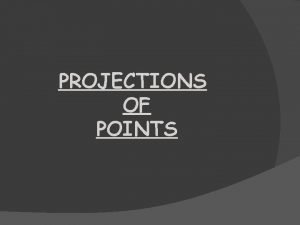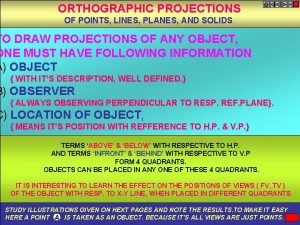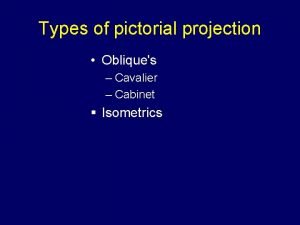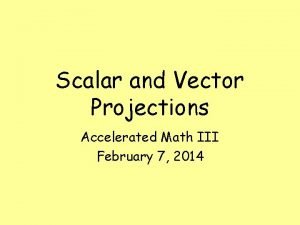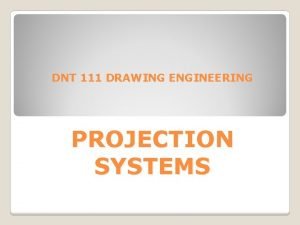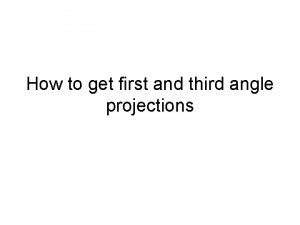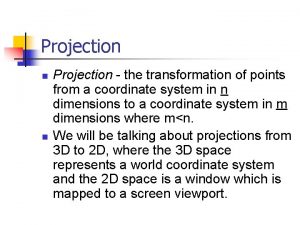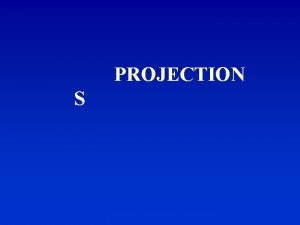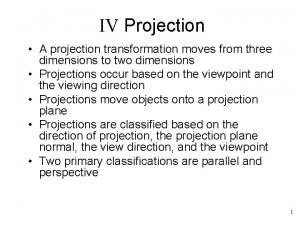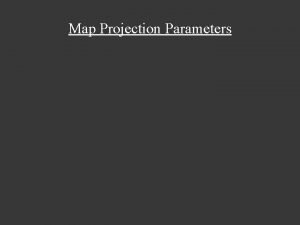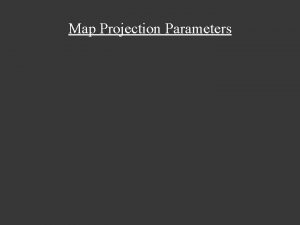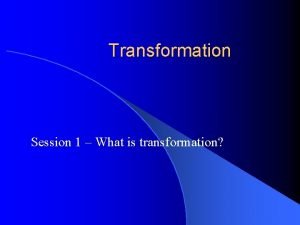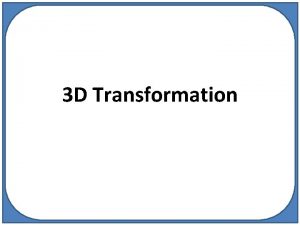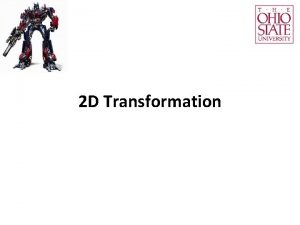Projection n n Projection the transformation of points































- Slides: 31

Projection n n Projection - the transformation of points from a coordinate system in n dimensions to a coordinate system in m dimensions where m<n. We will be talking about projections from 3 D to 2 D, where the 3 D space represents a world coordinate system and the 2 D space is a window which is mapped to a screen viewport.

Specifying a Projection n Two things must be specified n n Projection plane and a center of projection. A 2 D coordinate system onto which the 3 D image is to be projected. We’ll call this the VRP for view reference plane. Center of projection n A point in space which serves as an end point for projectors. We’ll refer to this point as the COP. It is also called a PRP for a projection reference point.

Projectors n Projectors - a ray originating at the center of projection and passing through a point to be projected. Here is an example of a projection:

Parallel Projection n A simple case of a projection is if the projectors are all in parallel. n What does this imply about the COP?

Direction of Projection n We can’t specify the COP for parallel projection n We’ll use Direction of Project (DOP) instead

Some Trivia n Planar geometric projection n n A projection onto a planar surface (planar) using straight lines (geometric). Foreshortening n Varying lengths of lines due to angle of presentation and/or distance from center of projection. Applies to both parallel and perspective projections.

Orthographic Projections n Orthographic projection n n Elevation n n parallel projection with the direction of projection and the projection plane normal parallel. an orthographic projection in which the view plane normal is parallel to an axis. The three elevations n n n front-elevation top-elevation (plan-elevation) side-elevation.

Axonometric orthographic projections n n Use projection planes which are not normal to an axis. They show more than one face of an object at a time. They induce uniform foreshortening unrelated to depth. AOP preserves parallelism of lines. It does not preserve angles.

Isometric projection n Axonometric orthographic projection where the projection plane normal (and the direction of projection) makes identical angles with each principle axis. How many of these are there?

Oblique Projection n Oblique projection n the projection plane normal and the direction of projection are at angles to each other. DOP VPN

Cavalier Projection n Why? An Oblique projection n DOP is at 45 degree angle to VPN Lines parallel to any axis are foreshortened equally. Lines parallel to the z axis appear at an angle a, which is dependent upon the direction of projection. Two common projections have a as 45° and 30°. 45 o 30 o

Cavalier Projection Angles DOP VPN

Cabinet projection n Oblique projection n n projection plane normal is at an arctan(2) = 63. 4° degree angle to the projection plane. (typically projecting onto the x, y plane) Lines parallel to the axis defining the projection plane are foreshortened equally. Lines parallel to the projection plane normal are halved!

Cabinet Projection DOP 63. 4 o VPN

Parallel Projection n After transforming the object to the eye space, parallel projection is relative easy – we could just drop the Z Xp = x Yp = y Zp = -d n We actually want to keep Z – why? (Xp, Yp) y z x (x, y, z)

Parallel Projection (2) n Open. GL maps (projects) everything in the visible volume into a canonical view volume (xmax, ymax, -far) (xmin, ymin, -near) gl. Ortho(xmin, xmax, ymin, ymax, near, far) (1, 1, -1) (-1, 1) Canonical View Volume

Parallel Projection (3) n Transformation sequence: 1. Translation (M 1): (-near = zmax, -far = zmin) -(xmax+xmin)/2, -(ymax+ymin)/2, -(zmax+zmin)/2 2. Scaling (M 2): 2/(xmax-xmin), 2/(ymax-ymin), 2/(zmax-zmin) M 2 x M 1 = 2/(xmax-xmin) 0 0 - (xmax+xmin)/(xmax-xmin) 0 2/(ymax-ymin) 0 - (ymax+ymin)/(ymax-ymin) 0 0 2/(zmax-zmin) -(zmax+zmin)/(zmax-zmin) 0 0 0 1

Perspective Projection n Perspective projections have projectors at angles to each other radiating from a center of projection. n Parallel lines not parallel to the projection plane will not appear parallel in the projection.

Vanishing Points n If not parallel? n n If the lines are not parallel anymore, they must meet somewhere. In 3 D space that point will be at infinity and is referred to as a vanishing point. There an infinite number of vanishing points. Axis vanishing points n Lines parallel to one of the major axis come to a vanishing point, these are called axis vanishing points. Only three axis vanishing points in 3 D space.

Center of Projection in Open. GL always puts the center of projection at 0, 0, 0 n n The projection plane is at z = -d This is sometimes called the “focal length” or “f”

gl. Frustum(left, right, bottom, top, znear, zfar) Frustums n The region we can see is called the frustum (right, top, -znear) (0, 0, 0) -zfar (left, bottom, -znear) znear and zfar are positive

glu. Perspective n How do we get from: n n glu. Perspective(fovy, aspect, znear, zfar) To n gl. Frustum(left, right, bottom, top, znear, zfar)

fov to near frustum (x, y, -znear) -z

Projection Structure Pinhole Camera Model of P(x, y, z) Projection y x Proportional! P'(x', y', z') -d -z

Matrix for Perspective Projection? n n n We need division to do projection! But, matrix multiplication only does multiplication and addition What about:

Homogenous Coordinates (again) n A 3 D homogeneous coordinate: n n n (x, y, z, w) We had been saying that w is 1 But – n n (x, y, z, w) corresponds to (x/w, y/w, z/w) Dividing by w is called homogenizing If w=1, x, y, z are unchanged. But, if w=-z/d? n (x/(-z/d), y/(-z/d), z/(-z/d)) = (-dx/z, -dy/z, -d)

The Entire Viewing Process n n Rotate world so that the COP is at 0, 0, 0 and DOP is parallel to the Z axis Apply perspective projection Homogenize Viewport transformation

Viewport Transformation (Window to Viewport) n Window n n n Area of the projection plane Typically some normalized area with 0, 0 in the center Viewport n n Area of the computer display window Example: n (0, 0) to (640, 480)

Window to Viewport Example n Assume Window (-1, -1) to (1, 1) n n Open. GL calls these normalized device coordinates Viewport (0, 0) to (640, 480) n Open. GL calls these window coordinates

Perspective Projection (6) n x’ Final Projection Matrix: 2 N/(xmax-xmin) y’ = 0 z’ 0 w’ 0 0 2 N/(ymax-ymin) (xmax+xmin)/(xmax-xmin) 0 x 0 y -2 F*N/(F-N) z 0 1 (ymax+ymin)/(ymax-ymin) 0 -(F + N)/(F-N) 0 -1 gl. Frustum(xmin, xmax, ymin, ymax, N, F) N = near plane, F = far plane

or po di rt na te s V indo ie w wt po o V co iew rt ce vi de D ) (2 es es di na t co or e en iz og H om rd in at es Object Coordinates W ed iz al or m N Pr oj Cl M ect ip co atrix ion o rd in at M od Ey e c Ma elvi oo trix ew Within Open. GL gl. Begin(GL_POLYGON); gl. Vertex 3 dv(a); gl. Vertex 3 dv(b); gl. Vertex 3 dv( c); gl. End();
 Straddle positioning
Straddle positioning Point of difference and point of parity
Point of difference and point of parity Draw the projections of the following points
Draw the projections of the following points Projections of points
Projections of points Line inclined to both hp and vp
Line inclined to both hp and vp Projection matrix
Projection matrix Cavalier view
Cavalier view Scalar projection vs vector projection
Scalar projection vs vector projection How to draw isometric view from orthographic view
How to draw isometric view from orthographic view 1st angle projection
1st angle projection Third angle system
Third angle system Mật thư anh em như thể tay chân
Mật thư anh em như thể tay chân Thang điểm glasgow
Thang điểm glasgow Tư thế ngồi viết
Tư thế ngồi viết ưu thế lai là gì
ưu thế lai là gì Thẻ vin
Thẻ vin Hát kết hợp bộ gõ cơ thể
Hát kết hợp bộ gõ cơ thể Thơ thất ngôn tứ tuyệt đường luật
Thơ thất ngôn tứ tuyệt đường luật Cái miệng bé xinh thế chỉ nói điều hay thôi
Cái miệng bé xinh thế chỉ nói điều hay thôi Các châu lục và đại dương trên thế giới
Các châu lục và đại dương trên thế giới Từ ngữ thể hiện lòng nhân hậu
Từ ngữ thể hiện lòng nhân hậu Diễn thế sinh thái là
Diễn thế sinh thái là V. c c
V. c c 101012 bằng
101012 bằng Hát lên người ơi
Hát lên người ơi Hổ sinh sản vào mùa nào
Hổ sinh sản vào mùa nào Frameset trong html5
Frameset trong html5 đại từ thay thế
đại từ thay thế Quá trình desamine hóa có thể tạo ra
Quá trình desamine hóa có thể tạo ra Vẽ hình chiếu vuông góc của vật thể sau
Vẽ hình chiếu vuông góc của vật thể sau Công thức tính thế năng
Công thức tính thế năng Thế nào là mạng điện lắp đặt kiểu nổi
Thế nào là mạng điện lắp đặt kiểu nổi


